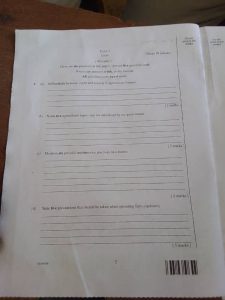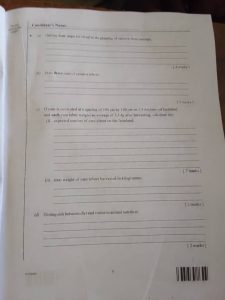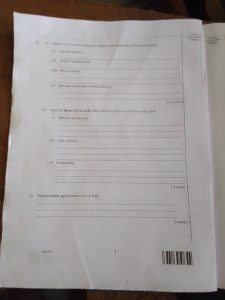Table of Contents
WAEC Agric practical Questions and answers 2023
Here is the questions





Not clear? Join our whatsapp group from top of the site and chat the admin
Answers
Another no 1
(1a)
Subsidy is financial assistance provided to farmers to reduce agricultural costs, while credit refers to financial support extended to farmers in the form of loans for agricultural activities.
(1b)
– Fertilizers
– Seeds
– Pesticides
– Agricultural machinery and equipment
– Irrigation systems
(1c)
– Regular oil changes and filter replacements.
– Inspection and replacement of belts and hoses.
– Battery maintenance.
– Tire maintenance.
– Cleaning and greasing.
– Regular engine and fluid inspections.
(1d)
– Read the manual and follow instructions.
– Wear proper personal protective equipment (PPE).
– Keep a safe distance from moving parts.
– Ensure proper training and skill for operation.
– Regularly inspect and maintain machinery for safety.
4(a)
1. Land preparation: Prepare the land by clearing, tilling, and making beds or ridges to accommodate the cassava’s stems.
2. Stem preparation: Cut fresh and healthy cassava stems into about 30 to 35cm long pieces, with at least three to four buds each. Then leave them in a shaded area to dry and harden for at least two to three days before planting.
3. Planting: Dig holes in the beds or ridges at regular intervals (usually 1.0m x 1.0m) and place a stem cutting inside each hole. Cover the cuttings with soil up to the topmost bud, and gently press down the soil around each stem cutting.
4. Weeding and maintenance: After planting, clear the area of weeds and other debris. Regularly maintain the crops by applying appropriate fertilizers, controlling pests and diseases, and managing soil moisture.
4(b)
1. Food: Cassava is a staple food crop in many regions, especially in Africa, Asia, and Latin America. The tubers contain high quantities of carbohydrates and are often eaten boiled, baked, or fried.
2. Industrial applications: Cassava can be processed into flour, starch, and ethanol. The starch is used in food products such as noodles, bread, and biscuits, while the ethanol is used as biofuel, and the flour is used in industrial glue and paper production.
3. Animal feed: Cassava leaves and peels, which are byproducts of cassava processing, can be used as animal feed. The leaves are rich in protein, vitamins, and minerals and can be fed to pigs, goats, cows, and rabbits.
Complete agricultural science
NUMBER 2.
ERN
2a.
Agricultural ecology, also known as agroecology, is a field of study that focuses on the ecological principles and practices of agriculture.
2b.
Crop
Livestock
2bii.
Soil composition
Climate
Water availability
2c
a.Clean and Prepare the Storage Area
b. Check Moisture Levels
c. Protect from Pests: Maize is vulnerable to pest infestations, such as weevils, moths, or rodents.
d. Maintain Adequate Ventilation
e. Practice First-In, First-Out (FIFO): Implement a “first-in, first-out” system when accessing the stored maize
2d.
a. Petunia (Petunia spp.)
b. Marigold (Tagetes spp.)
c. Geranium (Pelargonium spp.)
d. Begonia (Begonia spp.)
(2a)
(i) Agricultural ecology involves studying the interactions between agriculture and the environment, focusing on ecological processes and impacts.
(ii) An ecosystem, refers to a community of organisms and their interactions within a specific area, encompassing both living and non-living components.
(2b)
(i)
– Crop
– Live stock
(ii)
– Soil
– Climate
– Water
(2c)
– Ensure ventilation.
– Guard against pests.
– Keep bags elevated.
– Maintain cleanliness.
– Follow FIFO system.
(2d)
– Petunias
– Marigolds
– Begonias
– Geraniums
(3a)
(i) Causal organism: Root knot disease of tomato is caused by Meloidogyne spp. (nematode) both in soil and water, they infect the roots causing deformation.
(ii) Mode of transmission: The disease is transmitted through soil, water, weeds, farm equipment, and farm labourers.
(iii) Two symptoms: The symptoms of root knot disease include:
1. Galled root system: The infected root of a tomato plant typically becomes swollen and develops numerous small knots or galls on its surface and soil attached to the root which turns yellow.
2. Stunted growth: Infected tomato plants may become stunted and lack vigour and produce fewer flowers and fruit.
(iv) Two prevention and control measures:
1. Plant resistant varieties: Planting resistant tomato varieties which are not susceptible to nematodes, can be effective in preventing an outbreak of root knot disease.
2. Crop rotation:Crop rotation with non-host plants which are not susceptible to nematode attacks, for example, cereals, grasses, and legumes, can reduce the infestation of nematodes and lead to a significant decrease in nematode populations.
(3b)
(i) Fertilizer application:
1. Soil acidification: Overuse of chemical fertilizers can lead to soil acidification, causing pH to drop below optimal levels for plant growth.
2. Nutrient imbalances: Overuse of chemical fertilizers can also lead to nutrients imbalances, for example, excessive use of nitrogen can affect soil organic matter, mineral content and ultimately crop productivity.
3. Environmental pollution: Excessive use of fertilizers can lead to the accumulation of nitrates in the soil and groundwater, resulting in environmental pollution.
(ii) Clean clearing:
1. Soil erosion: Removing vegetation from the soil surface can increase soil erosion due to water and wind.
2. Nutrient depletion: Clearing land without adequate measures can remove the nutrient-rich topsoil, which leads to nutrient depletion and soil degradation.
3. Habitat loss: Clearing land can result in habitat loss for various species of wildlife and plants.
(iii) Overgrazing:
1. Soil compaction: Excessive grazing can lead to soil compaction, which reduces infiltration rates and water-holding capacity, affecting soil quality and crop productivity.
2. Soil erosion and nutrient depletion: Overgrazing can lead to soil erosion, loss of topsoil, loss of vegetation cover, and reduced nutrient cycling, leading to nutrient depletion and decreased productivity.
3. Biodiversity loss: Overgrazing can also result in the loss of habitat for many species of plants and animals and can consequently lead to a decrease in biodiversity.
(3c)
Three agricultural uses of land include:
1. Crop production: Land is used to grow a wide range of crops, including grains, vegetables, fruits.
2. Animal husbandry: Land is also used for rearing livestock, including cattle, goats, and sheep.
3. Forestry: Land is also used for the cultivation of trees for timber production and other forest products.
*ANOTHER NUMBER 2*
(2ai)
Agricultural ecology is the study of how plants, animals, and the environment interact within agricultural systems. It focuses on understanding the relationships between agricultural practices, the health of ecosystems, and the well-being of both humans and nature.
Or use this
(2ai)
Agricultural ecology is a field of study that examines the ecological processes and interactions within agricultural systems. It involves understanding the relationships between plants, animals, microorganisms, and their environment in the context of agriculture.
(2aii)
An Ecosystem refers to the natural environment in which crops, livestock, and other organisms interact with each other and with their surroundings. It includes the plants, animals, microorganisms, soil, water, and air within a farming area.
Or
An Ecosystem refers to the complex network of interactions between living organisms (plants, animals, microorganisms) and their physical environment (soil, water, air) within a specific agricultural area. It involves the flow of energy, the cycling of nutrients, and the interdependence of different components.
(2bi)
{Choose any two}
(i) plants.
(ii) animals.
(iii) decomposers.
(2bii)
{Choose any three}
(i) Light
(ii) air
(iii) soil
(iv) nutrients.
(2c)
– Ensure ventilation.
– Guard against pests.
– Keep bags elevated.
– Maintain cleanliness.
– Follow FIFO system.
(2d)
– Petunias
– Marigolds
– Begonias
– Geraniums
(5a)
TABULATE
=SYMPTOMS=
(iv) Red lesions on the heads chest,forelegs and ridges
=DISEASES=
(i) Tuberculosis
(viii) Rinder pest
=PREVENTION=
(ii) Isolation if infected animal
(iii) Good sanitation
(v) Vaccination
(vii) Good sanitation
(viii) Vaccination
(ix) Restrict infected animals movement
(5bi)
(i)To lays lots of eggs
(ii) It produce chemical scents that help regulate the unity of the colony
(5bii)
(i)They feed the queen
(ii)They help in making the wax
(5c)
(i) They aid the decompositions
(ii) To prevent pollution
(iii) It makes the action of the bacteria rapid
(iv) To Prevent interference by rain or sun
(v) To retain moisture and reduce odour

